Mori Sushi (Los Angeles, CA)
Mori Sushi
11500 W Pico Blvd, Los Angeles, CA 90064
310.479.3939
www.morisushi.org
Sat 03/05/2011, 06:30p-09:50p

LA's a sushi town, no doubt. As such, the question of the "best" sushi inevitably comes up. For me, the answer to this query is simple: Urasawa. The issue of number two, however, is a stickier wicket, with the most popular responses being Sushi Zo and Mori Sushi, both Michelin-starred places. I'd actually dined at Mori way back in 2007, but a questionable ban on photography left a bad taste in my mouth, and kept me away for all these years. However, there seemed to have been a renewed interest in Mori over the past couple of months. This, along with news that cameras were now allowed, compelled me to give the restaurant another go.
About the Chef: Owner and Chief Sushi Chef Morihiro Onodera was born in 1964 in the town of Fujisawa, Iwate Prefecture, Japan. He had hopes of becoming a sushi chef at an early age, largely due to the influences of his grandmother. Mori excelled at baseball and music as a youngster, but immediately began his culinary training after graduating high school. He moved to the Bunkyo Ward of Tokyo, where he worked for three years at Kintaro Sushi, honing his skills in traditional Japanese cuisine, sushi in particular. However, Onodera wasn't satisfied, and after being inspired by Eikichi Yazawa's best-selling 1978 autobiography Nariagari, he decided to move to the United States. Mori packed one bag, purchased a one-way ticket to America, and landed here in 1985 to begin his culinary career in the States. He first worked for Masaru Michite at the famed Katsu on Hillhurst in Los Feliz, which was the sushi spot in the 1980's (it closed in 1998).
As an aside, Michite was a pioneer in the LA sushi scene, and also owned Café Katsu on Sawtelle, Katsu 3rd on Third Street, and most significantly, Restaurant Katsu in Studio City. Restaurant Katsu debuted in 2000, but was rechristened Tama Sushi in 2002 following a fire. Tama achieved quite a bit of popularity, but the space shuttered in 2008, only to be taken over by Katsuya Uechi and turned into Kiwami. Michite then opened Katsu Beverly Hills, but the restaurant never caught on, and closed in mid 2009. His current whereabouts are unknown.
Getting back to Mori, following his stint at Katsu, Onodera worked at R23 in Downtown and Nobu's seminal Matsuhisa on Restaurant Row. Then, the Chef took a detour to New York, taking on a position at the legendary Hatsuhana, which is where Naomichi Yasuda first made a name for himself. He eventually returned to the Southland, landing at the well-regarded Takao in Brentwood. Then finally, in 2000, Mori opened his eponymous eatery in West LA.
Mori's a notorious stickler when it comes to his ingredients, even going as far as to make his own soy sauce and grow his own rice. The rice is particularly noteworthy. It comes from Sacramento, where it's grown by Ichiro Tamaki, a farmer hailing from Fukushima Prefecture. Koshihikari rice is used for sushi, while the yumegokochi variety is utilized in everything else. Apparently, in order to further elevate their appreciation for the rice, members of Mori's staff are even invited to visit the rice fields during planting and harvesting. This custom rice is then shipped unhulled to retain its freshness, then polished daily on site for maximum effect. This level of care is also undertaken in the dishware, most of which is handmade by Mori himself and designed to maximize flavor and appearance (he first started producing ceramics during his time in Greenwich Village, New York).
As for the food here, diners may choose to order both sushi and cooked items à la carte. At the same time, three omakase options are available: Sashimi Moriawase, basically an assorted combination platter of sashimi followed by sushi; Sushi Omakase, with three appetizers followed by sushi; and the Omakase, which is basically the Sushi Omakase with additional hot courses. We opted for the last choice, which was priced at $170 per head for our party of four. The menu was executed by Chef Masanori "Maru" Nagano, a Japanese native who's been with Mori for ten years.

To drink, I began with an Allagash White [$7.50], sort of a quintessential example of the witbier style, showing off a refreshing citrus sweetness backed by a bit of pepper on the backpalate.
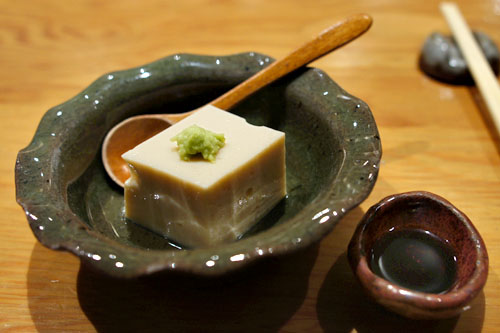
1: Homemade Tofu
The meal started with a cube of Mori's housemade tofu, garnished with freshly-grated wasabi and a tiny bowl of homemade soy. The tofu was very mild at first, with the characteristic flavor of soybean growing subtly with time. As a result, the umami-tinged smack of the shoyu was key in adding richness and depth to the dish, and I appreciated the heat imparted by the wasabi as well.
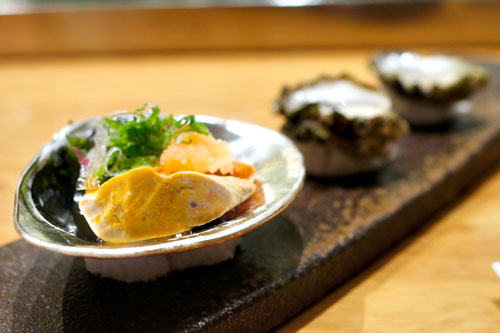
2: Ankimo & Kumamoto Oysters
Next up was a combination of monkfish liver and oysters. I attacked the Kumamotos first, and appreciated their subdued sweetness, perked up by the application of sudachi and finished with a lovely ocean-y relish. The ankimo, meanwhile, was delicious as well. The liver demonstrated its signature luxuriousness, and was beautifully balanced by the paired scallion and momiji oroshi, while the seaweed gave the dish a lovely close.

3: Seasonal Fish Soup
Placed before us next was an intoxicating stew of red snapper, shrimp, asari clam, mitsuba, and bell pepper, teeming with an aroma of umami-tinged brine. The snapper was falling-apart tender with a subtle flavor, while the shrimp arrived cooked through, but surprisingly not overdone. My favorite item was the clam, with its delightful ocean-y flavor that paired perfectly with the tangy vegetal essence of the broth. Very nice.

With our beers dispensed with, it was time to move on to sake, specifically the Hoyo 'Genji' Junmai "Shining Prince" [$50] from Miyagi's Uchigasaki Brewing Company. I found this relatively viscous and somewhat sweet, with a fresh apple character bound by a bit of alcoholic character.
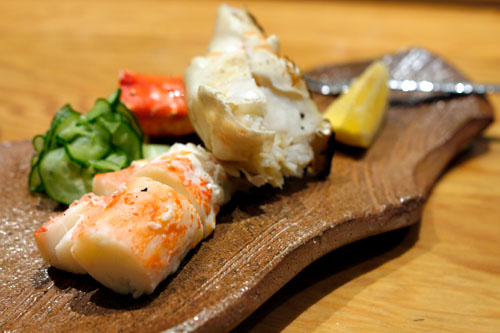
4: Grilled Alaskan King Crab Sunomono
Grilled legs of king crab were delectable, with a perfectly supple texture and creeping sweetness accented by a touch of bitter char. I enjoyed the crab alone, but it was even better when taken with the piquant tang of included vinegar dipping sauce.

5: Abalone Tempura
Our final appetizer course brought us a superb tempura of abalone. The gastropod had a wonderful, snappy yet soft consistency that I adored, especially in concert with its crisp tempura exterior. Its flavor was restrained, yet satisfying, and went gorgeously with a dash of the included French fleur de sel. Tempura'd shishito peppers were also included, and were delectable in their own right as well.
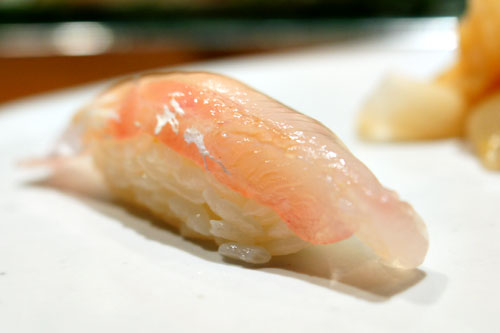
6: Red Snapper / Tai
Our gauntlet of sushi began with red snapper, done up in a kobujime fashion, which means that the fish is treated with konbu kelp. In the process, excess moisture from the fish is transferred to the kelp, and the result on the palate is a richer, more complex flavor.
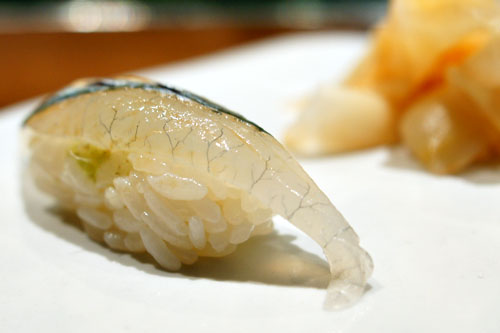
7: Needlefish / Sayori
Needlefish was absolutely lovely, with a wondrous texture and slightly fishy flavor countered by a well-placed smidge of wasabi tang.
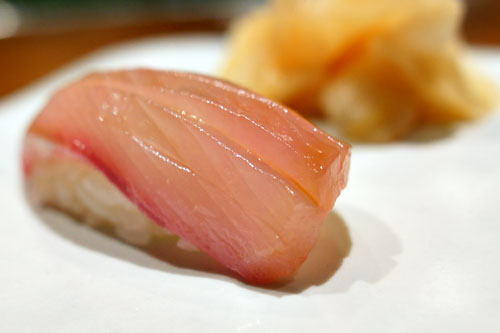
8: Wild Yellowtail / Seki Buri
Previously, I'd had seki aji and seki saba, special types of mackerel caught in the Bungo channel near Saganoseki, Kyushu. This was the first time, however, that I'd experienced seki buri, or wild yellowtail from the region. Indeed, it was truly a cut above your typical hamachi, with a bolder, more robust, more mature flavor, and a perfect amount of fattiness.
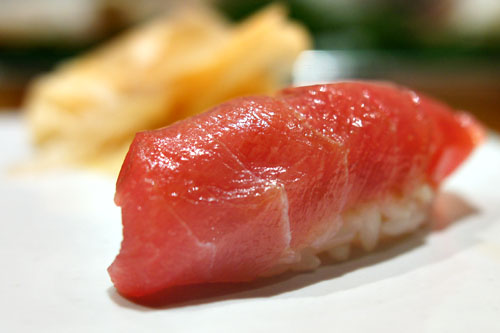
9: Medium Fatty Bigeye Tuna / Mebachi Chutoro
Chutoro of bigeye tuna was all that you'd expect, with a melty texture and just the right modicum of marbling, perfectly merged with the relative levity of the rice.

10: Japanese Mackerel / Saba
Mackerel from Japan was wonderfully textured, and showed off its characteristic fishiness, which lingered long on the palate. This was our Chef's personal favorite of the evening.
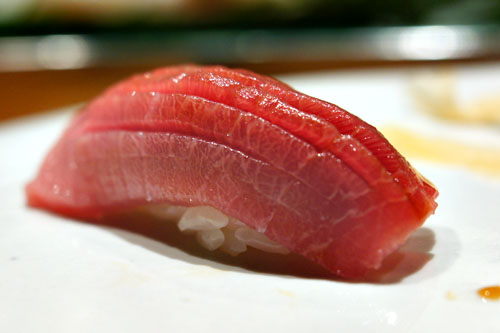
11: Medium Fatty Blue Fin Tuna / Kuromaguro Chutoro
Compared to the bigeye tuna above, the blue fin chutoro was noticeably creamier in consistency (note the more apparent veins of fat) and more luxurious overall. At the same time, the rice was again absolutely crucial in balancing the bite.
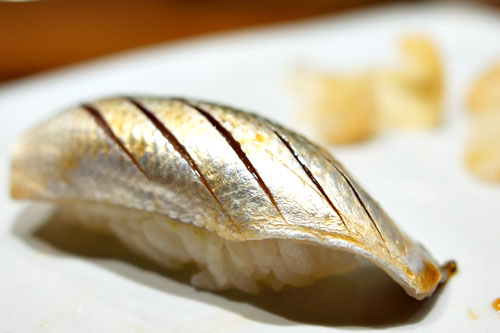
12: Gizzard Shad / Kohada
Kohada arrived pickled in vinegar, which gave the fish a slight sourness that complemented the shad's strong flavor faultlessly. At the same time, I much appreciated the kohada's firm, satisfying texture.
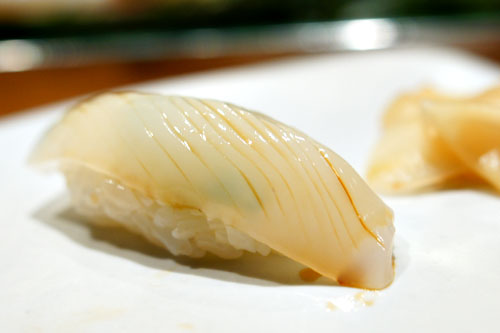
13: Cuttlefish / Sumi Ika
Cuttlefish was expectedly creamy in consistency, yet with a bit of a crunch as well. Its savor was rather mild, and accentuated by the minty tang of the included sliver of shiso.
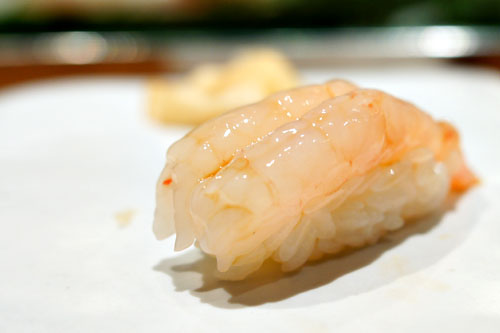
14: Sweet Shrimp / Amaebi
Sweet shrimp were sourced from the Boston area, and were very, very creamy, with a creeping amount of sugary brine to go along.
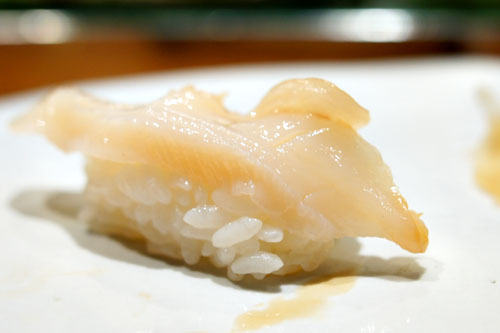
15: Geoduck / Mirugai
The unfortunately-named geoduck, also known as giant clam, was unabashedly crunchy, with a certain ocean-y sweetness augmented by a sharp, citric tang.
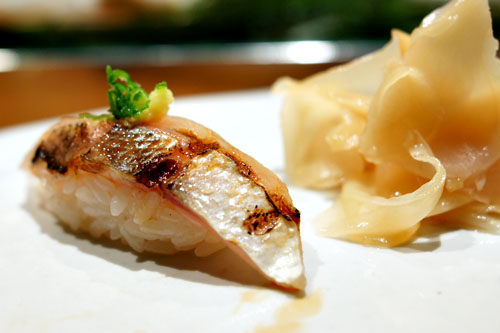
16: Seared Baby Barracuda / Tataki Kamasu
Barracuda isn't a common find on menus, and indeed, this was my first time having the fish in sushi form. It conveyed an almost undetectable sweetness, along with a faint fishiness that was deftly moderated by the bitterness the char. One of our favorites.
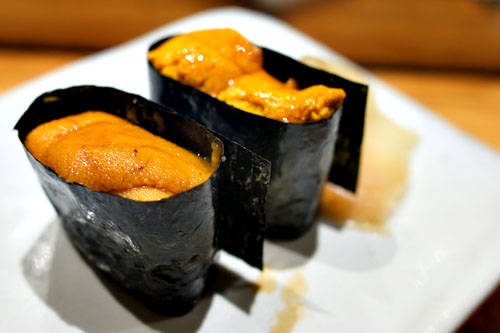
17: Sea Urchin Roe / Uni
The best uni in the world comes from either Santa Barbara or Hokkaido, and we had the pleasure of trying both varieties back to back. The Japanese varietal showed off a sharp, yet restrained brine, which then led to a characteristic urchin sweetness, tempered by the lovely relish of nori. The Santa Barbara uni, on the other hand, was noticeably creamier, sweeter, and more cohesive. Both were tasty, but if cornered, I suppose that I'd have to give the victory to the American contender.

18: Salmon Roe / Ikura
Following the sea urchin roe was salmon roe, presented here topped with yuzu zest. It was one of the better preparations of ikura that I've had, with the amber globules bursting forth forcefully with their ocean-y relish upon mastication. I especially appreciated the countervailing flavor imparted by the yuzu.
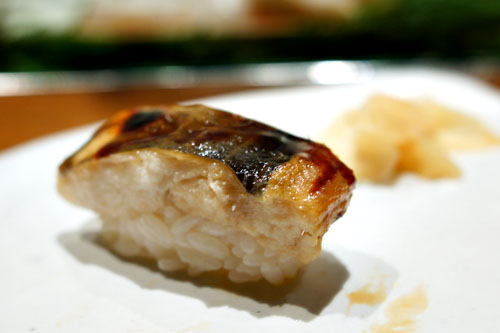
19: Sea Eel / Anago
Anago, again, was one of the stronger versions that I've had. The sea eel was surprisingly meaty, hearty even, with rich, dark flavors that lingered on the palate.
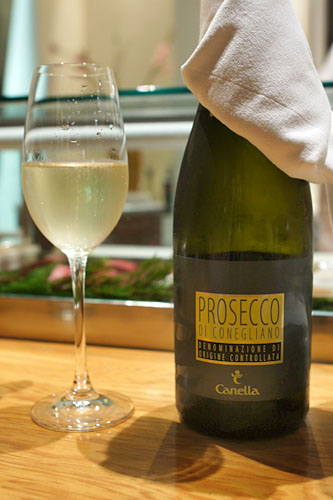
To close out the night, we ordered up a bottle of Canella Prosecco di Conegliano [$40], which we shared with the chefs. This was an undoubtedly easy-drinking sparkler, with juicy notes of pear and apple balanced by a lively effervescence and a slight bit of minerality.
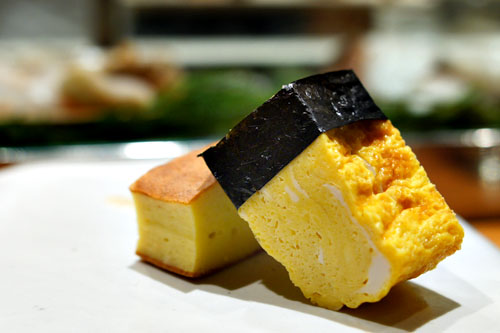
20: Egg / Tamago
As usual, tamagoyaki served as the closer for the savory section of the meal. Two types were offered. The first (in front) was more of your traditional variety--eggy, but semisweet. The other utilized fish cake and was thus more intriguing, with a subtle fishiness added to the fray.
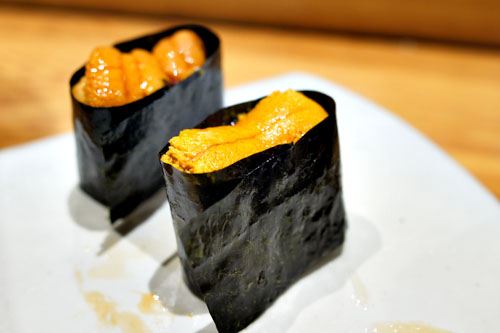
21: Sea Urchin Roe / Uni
We requested a second round of uni (which was complementary) in order to reevaluate the relative merits of the Hokkaido and Santa Barbara versions. I still preferred the latter.

22: Black Sesame Ice Cream
Dessert comprised a singular scoop of black sesame ice cream, loaded with sesame flavor and reminding us a bit of Chinese tangyuan.

23: Hojicha
Hojicha, a type of roasted green tea, to round things out.
I'm happy to report that we left Mori sated and satisfied. It was a much better experience than I'd had four years ago, and indeed, one of the best sushi experiences I've had ever in Los Angeles. The sushi itself was pretty much faultless, and the cooked dishes were tasty in their own right. Number two? I can definitely see it.

11500 W Pico Blvd, Los Angeles, CA 90064
310.479.3939
www.morisushi.org
Sat 03/05/2011, 06:30p-09:50p

LA's a sushi town, no doubt. As such, the question of the "best" sushi inevitably comes up. For me, the answer to this query is simple: Urasawa. The issue of number two, however, is a stickier wicket, with the most popular responses being Sushi Zo and Mori Sushi, both Michelin-starred places. I'd actually dined at Mori way back in 2007, but a questionable ban on photography left a bad taste in my mouth, and kept me away for all these years. However, there seemed to have been a renewed interest in Mori over the past couple of months. This, along with news that cameras were now allowed, compelled me to give the restaurant another go.
About the Chef: Owner and Chief Sushi Chef Morihiro Onodera was born in 1964 in the town of Fujisawa, Iwate Prefecture, Japan. He had hopes of becoming a sushi chef at an early age, largely due to the influences of his grandmother. Mori excelled at baseball and music as a youngster, but immediately began his culinary training after graduating high school. He moved to the Bunkyo Ward of Tokyo, where he worked for three years at Kintaro Sushi, honing his skills in traditional Japanese cuisine, sushi in particular. However, Onodera wasn't satisfied, and after being inspired by Eikichi Yazawa's best-selling 1978 autobiography Nariagari, he decided to move to the United States. Mori packed one bag, purchased a one-way ticket to America, and landed here in 1985 to begin his culinary career in the States. He first worked for Masaru Michite at the famed Katsu on Hillhurst in Los Feliz, which was the sushi spot in the 1980's (it closed in 1998).
As an aside, Michite was a pioneer in the LA sushi scene, and also owned Café Katsu on Sawtelle, Katsu 3rd on Third Street, and most significantly, Restaurant Katsu in Studio City. Restaurant Katsu debuted in 2000, but was rechristened Tama Sushi in 2002 following a fire. Tama achieved quite a bit of popularity, but the space shuttered in 2008, only to be taken over by Katsuya Uechi and turned into Kiwami. Michite then opened Katsu Beverly Hills, but the restaurant never caught on, and closed in mid 2009. His current whereabouts are unknown.
Getting back to Mori, following his stint at Katsu, Onodera worked at R23 in Downtown and Nobu's seminal Matsuhisa on Restaurant Row. Then, the Chef took a detour to New York, taking on a position at the legendary Hatsuhana, which is where Naomichi Yasuda first made a name for himself. He eventually returned to the Southland, landing at the well-regarded Takao in Brentwood. Then finally, in 2000, Mori opened his eponymous eatery in West LA.
Mori's a notorious stickler when it comes to his ingredients, even going as far as to make his own soy sauce and grow his own rice. The rice is particularly noteworthy. It comes from Sacramento, where it's grown by Ichiro Tamaki, a farmer hailing from Fukushima Prefecture. Koshihikari rice is used for sushi, while the yumegokochi variety is utilized in everything else. Apparently, in order to further elevate their appreciation for the rice, members of Mori's staff are even invited to visit the rice fields during planting and harvesting. This custom rice is then shipped unhulled to retain its freshness, then polished daily on site for maximum effect. This level of care is also undertaken in the dishware, most of which is handmade by Mori himself and designed to maximize flavor and appearance (he first started producing ceramics during his time in Greenwich Village, New York).
As for the food here, diners may choose to order both sushi and cooked items à la carte. At the same time, three omakase options are available: Sashimi Moriawase, basically an assorted combination platter of sashimi followed by sushi; Sushi Omakase, with three appetizers followed by sushi; and the Omakase, which is basically the Sushi Omakase with additional hot courses. We opted for the last choice, which was priced at $170 per head for our party of four. The menu was executed by Chef Masanori "Maru" Nagano, a Japanese native who's been with Mori for ten years.

To drink, I began with an Allagash White [$7.50], sort of a quintessential example of the witbier style, showing off a refreshing citrus sweetness backed by a bit of pepper on the backpalate.

1: Homemade Tofu
The meal started with a cube of Mori's housemade tofu, garnished with freshly-grated wasabi and a tiny bowl of homemade soy. The tofu was very mild at first, with the characteristic flavor of soybean growing subtly with time. As a result, the umami-tinged smack of the shoyu was key in adding richness and depth to the dish, and I appreciated the heat imparted by the wasabi as well.

2: Ankimo & Kumamoto Oysters
Next up was a combination of monkfish liver and oysters. I attacked the Kumamotos first, and appreciated their subdued sweetness, perked up by the application of sudachi and finished with a lovely ocean-y relish. The ankimo, meanwhile, was delicious as well. The liver demonstrated its signature luxuriousness, and was beautifully balanced by the paired scallion and momiji oroshi, while the seaweed gave the dish a lovely close.

3: Seasonal Fish Soup
Placed before us next was an intoxicating stew of red snapper, shrimp, asari clam, mitsuba, and bell pepper, teeming with an aroma of umami-tinged brine. The snapper was falling-apart tender with a subtle flavor, while the shrimp arrived cooked through, but surprisingly not overdone. My favorite item was the clam, with its delightful ocean-y flavor that paired perfectly with the tangy vegetal essence of the broth. Very nice.

With our beers dispensed with, it was time to move on to sake, specifically the Hoyo 'Genji' Junmai "Shining Prince" [$50] from Miyagi's Uchigasaki Brewing Company. I found this relatively viscous and somewhat sweet, with a fresh apple character bound by a bit of alcoholic character.

4: Grilled Alaskan King Crab Sunomono
Grilled legs of king crab were delectable, with a perfectly supple texture and creeping sweetness accented by a touch of bitter char. I enjoyed the crab alone, but it was even better when taken with the piquant tang of included vinegar dipping sauce.

5: Abalone Tempura
Our final appetizer course brought us a superb tempura of abalone. The gastropod had a wonderful, snappy yet soft consistency that I adored, especially in concert with its crisp tempura exterior. Its flavor was restrained, yet satisfying, and went gorgeously with a dash of the included French fleur de sel. Tempura'd shishito peppers were also included, and were delectable in their own right as well.

6: Red Snapper / Tai
Our gauntlet of sushi began with red snapper, done up in a kobujime fashion, which means that the fish is treated with konbu kelp. In the process, excess moisture from the fish is transferred to the kelp, and the result on the palate is a richer, more complex flavor.

7: Needlefish / Sayori
Needlefish was absolutely lovely, with a wondrous texture and slightly fishy flavor countered by a well-placed smidge of wasabi tang.

8: Wild Yellowtail / Seki Buri
Previously, I'd had seki aji and seki saba, special types of mackerel caught in the Bungo channel near Saganoseki, Kyushu. This was the first time, however, that I'd experienced seki buri, or wild yellowtail from the region. Indeed, it was truly a cut above your typical hamachi, with a bolder, more robust, more mature flavor, and a perfect amount of fattiness.

9: Medium Fatty Bigeye Tuna / Mebachi Chutoro
Chutoro of bigeye tuna was all that you'd expect, with a melty texture and just the right modicum of marbling, perfectly merged with the relative levity of the rice.

10: Japanese Mackerel / Saba
Mackerel from Japan was wonderfully textured, and showed off its characteristic fishiness, which lingered long on the palate. This was our Chef's personal favorite of the evening.

11: Medium Fatty Blue Fin Tuna / Kuromaguro Chutoro
Compared to the bigeye tuna above, the blue fin chutoro was noticeably creamier in consistency (note the more apparent veins of fat) and more luxurious overall. At the same time, the rice was again absolutely crucial in balancing the bite.

12: Gizzard Shad / Kohada
Kohada arrived pickled in vinegar, which gave the fish a slight sourness that complemented the shad's strong flavor faultlessly. At the same time, I much appreciated the kohada's firm, satisfying texture.

13: Cuttlefish / Sumi Ika
Cuttlefish was expectedly creamy in consistency, yet with a bit of a crunch as well. Its savor was rather mild, and accentuated by the minty tang of the included sliver of shiso.

14: Sweet Shrimp / Amaebi
Sweet shrimp were sourced from the Boston area, and were very, very creamy, with a creeping amount of sugary brine to go along.

15: Geoduck / Mirugai
The unfortunately-named geoduck, also known as giant clam, was unabashedly crunchy, with a certain ocean-y sweetness augmented by a sharp, citric tang.

16: Seared Baby Barracuda / Tataki Kamasu
Barracuda isn't a common find on menus, and indeed, this was my first time having the fish in sushi form. It conveyed an almost undetectable sweetness, along with a faint fishiness that was deftly moderated by the bitterness the char. One of our favorites.

17: Sea Urchin Roe / Uni
The best uni in the world comes from either Santa Barbara or Hokkaido, and we had the pleasure of trying both varieties back to back. The Japanese varietal showed off a sharp, yet restrained brine, which then led to a characteristic urchin sweetness, tempered by the lovely relish of nori. The Santa Barbara uni, on the other hand, was noticeably creamier, sweeter, and more cohesive. Both were tasty, but if cornered, I suppose that I'd have to give the victory to the American contender.

18: Salmon Roe / Ikura
Following the sea urchin roe was salmon roe, presented here topped with yuzu zest. It was one of the better preparations of ikura that I've had, with the amber globules bursting forth forcefully with their ocean-y relish upon mastication. I especially appreciated the countervailing flavor imparted by the yuzu.

19: Sea Eel / Anago
Anago, again, was one of the stronger versions that I've had. The sea eel was surprisingly meaty, hearty even, with rich, dark flavors that lingered on the palate.

To close out the night, we ordered up a bottle of Canella Prosecco di Conegliano [$40], which we shared with the chefs. This was an undoubtedly easy-drinking sparkler, with juicy notes of pear and apple balanced by a lively effervescence and a slight bit of minerality.

20: Egg / Tamago
As usual, tamagoyaki served as the closer for the savory section of the meal. Two types were offered. The first (in front) was more of your traditional variety--eggy, but semisweet. The other utilized fish cake and was thus more intriguing, with a subtle fishiness added to the fray.

21: Sea Urchin Roe / Uni
We requested a second round of uni (which was complementary) in order to reevaluate the relative merits of the Hokkaido and Santa Barbara versions. I still preferred the latter.

22: Black Sesame Ice Cream
Dessert comprised a singular scoop of black sesame ice cream, loaded with sesame flavor and reminding us a bit of Chinese tangyuan.

23: Hojicha
Hojicha, a type of roasted green tea, to round things out.
I'm happy to report that we left Mori sated and satisfied. It was a much better experience than I'd had four years ago, and indeed, one of the best sushi experiences I've had ever in Los Angeles. The sushi itself was pretty much faultless, and the cooked dishes were tasty in their own right. Number two? I can definitely see it.

16 Comments:
I can't beleive I still haven't eaten at Mori or Zo!
Kevin - awesome pics and review again.
I know you use a Sony DSLR with a macro lens, but what expose settings do you generally use in typical low-light restaurant environments? Also, your white balance seems to be spot on all the time. Do you use a gray card, or shoot in RAWa and fix it in post?
Ooops, I mean *exposure* settings.
Jai: How come? It seems like you haven't been eating out at all as of late.
Kevin: The light actually wasn't bad here. I was at ISO400, f4.0, 1/25s. Usually it's more like ISO1600, F2.0, 1/10s. As for WB, I evaluate at the scene (it's usually around 2500K) and adjust if needed in PS.
Kevin, First time poster- however long time reader. I reached out to you recently for a dinner suggestion for my boyfriends birthday and we went to Providence for the 10 course tasting menu with wine pairing at the Chef's table. Very happy, so thank you.
I wanted to ask if you've ever tried Sushi Masu? The Omakase is 50-65 dollars and unbelievable. I recommend you try it, the spicy tuna crispy rice is incredible. Just make sure you bring your own Sake- their selection is limited. :)
Hey Kevin: Was this the place that originally did not let you photograph it awhile back? If so, how did you approach chef about doing the review? Hopefully, your reputation now precedes you and they want you doing it.
By the way it looked awesome.
Sydney: I've heard of Sushi Masu, but haven't been yet (it's the place near Wakasan I believe). Omakase for $65 does sound like a real bargain though.
Evan: Yep, this is that infamous place. I asked our chef if we could photograph, and he said that it was OK, though he requested that we only shoot the food, and not him.
Hey Kevin. Fantastic review. I was just at Mori myself about a month ago and had a very similar course so this is making me quite hungry! Small correction: I think your descriptions of the Santa Barbara uni and Hokkaiko uni are swapped. In general, Santa Barbara uni tends to exhibit a much stronger briny flavor compared to Japanese uni.
Interesting comment about the uni actually. One of my dining companions felt the same way. However, the rest of us thought that the Hokkaido uni was brinier. We even ordered another round of the stuff just to make sure.
Kevin- The pictures are amazing. I am literally sitting here salivating over these dishes. Great review!
Thanks Josie! Have you been yet? Where's your favorite sushi place?
It's great that you went back and liked it! I've always thought that Mori was hands-down better than Zo. I've got to take you over to Asanebo someday. Sushi is not quite as good as Mori (but still excellent), but their cooked dishes and sashimi is better.
Yep, definitely happy that I went back, and interestingly, the new owner Masanori Nagano was our chef.
I wasn't enthralled with Asanebo last time I went, but I'm willing to give it another chance.
I returned to Mori recently (full review) and with my camera (the previous times were before I got over the top with my blogging).
Good stuff! I certainly think better than Zo. Still I really like the Omakase at Sushi Sushi. Somehow the fish itself has a little more punch.
Andy, I think I'd have to agree with you on Zo; the variety here appeals to me. You're right though--I still need to make it out to Sushi Sushi.
You left out the Spicy Tuna Tacos - they are absolutely fabulous!!!
Post a Comment
Subscribe to Post Comments [Atom]
<< Home